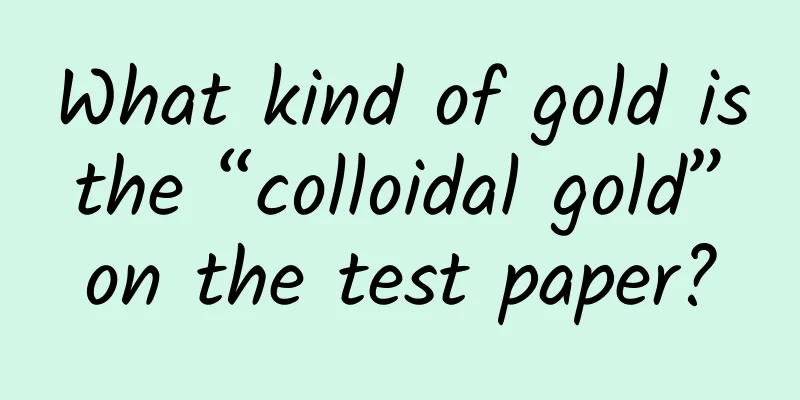What kind of gold is the “colloidal gold” on the test paper?

|
Produced by: Science Popularization China Author: Lu Wensheng (Institute of Chemistry, Chinese Academy of Sciences) Producer: China Science Expo Many people have used antigen test kits or pregnancy test sticks, and many people may have noticed that there is a parenthesis after their names, saying "colloidal gold method". While these reagents bring us surprises or shocks, has anyone tried to figure out what kind of gold colloidal gold is? HCG Test Kit (Photo credit: Photo taken by the author) What is Colloidal Gold? The first thing to make clear is that colloidal gold really contains gold, but the gold is in colloidal form. The term "colloid" was proposed by British chemist T. Graham in 1861. When studying the diffusion rate of solute molecules in a solution, he found that if parchment (as a semipermeable membrane) is used to separate a specific solution from water, a class of substances such as inorganic salts and sugar can quickly diffuse through the parchment into the water, and when the solvent evaporates, they are easy to precipitate into crystals; another class of substances such as gelatin, tannin, protein, aluminum hydroxide, etc., diffuse slowly, and are extremely difficult or even impossible to penetrate the parchment, and will become a viscous colloid after evaporation. Based on this discovery, he divided matter into two categories: the former was called crystalloid and the latter was called colloid. These are some jellies, which are also colloids. T. Graham gave the name colloid because some substances would turn into jelly-like substances after evaporation. (Image source: Wikipedia) However, with the development of science, people found that such classification was not appropriate. For example, Russian scientist Weiman discovered that when the inorganic salt sodium chloride is dispersed in alcohol, it also has the properties of slow diffusion and inability to pass through semipermeable membranes. Therefore, according to the modern definition, colloid actually refers to a highly dispersed dispersion system, and the dispersed particles in the colloid are extremely small, only 1-1000 nanometers (this data comes from "Chemical Terminology", where 1 nanometer is one billionth of 1 meter). Now, when we talk about colloids, it is no longer limited to certain specific solutions. The dispersed phase of the colloid can be solid, gas and liquid, and the dispersed particles in the colloid can also exist in the form of solid, liquid and gas. The dispersed phase and dispersed particles can combine to form a variety of different colloids. Mist is a kind of colloid, the dispersed phase is air, and the dispersed particles are small droplets suspended in the air. (Image source: Wikipedia) Foam is another form of colloid. Taking milk as an example, the dispersed phase is liquid milk, and the dispersed particles are tiny air bubbles. (Image source: Wikipedia) How to make colloidal gold? Since ancient times, gold has been widely loved and studied by people for its shining luster and rare characteristics. It can even be said that modern chemistry started on the basis of "alchemy". Therefore, the history of people's preparation of colloidal gold is actually earlier than the emergence of the concept of "colloid". In 1857, Michael Faraday discovered that by adding carbon disulfide, he could stabilize the "particles" formed by phosphorus reduction of gold chloride aqueous solution to produce a " beautiful ruby fluid ." However, he did not name the product "colloidal gold" at the time. To date, most synthetic methods used to obtain colloidal gold follow a similar strategy, using a solvated gold salt as a precursor and reducing the gold salt in the presence of a surface protectant, which prevents the resulting gold particles from aggregating, thereby stabilizing the colloidal gold. Transmission electron microscope photo of colloidal gold (Image source: provided by the author) The appearance of "ruby fluid" is completely different from the traditional impression of the color of gold. In fact, this is the characteristic of colloidal gold - it can present a variety of different bright colors, rather than pure gold. This is also the reason why colloidal gold can be used as a variety of reagents. Mie used Maxwell's electromagnetic theory to calculate that the polychromaticity of colloids comes from the absorption and scattering of light by the gold particles contained in the colloidal system. When light hits the colloid, only a portion of the light can pass through, and the rest is absorbed, scattered or reflected. Many colloids are colorless because they absorb light very weakly in all bands of visible light and the absorption is roughly the same. If the colloid has a strong selective absorption of a certain wavelength in the visible light, the wavelength portion of the transmitted light will become weak, and the transmitted light will show the complementary color of the wavelength. Taking "ruby" colored colloidal gold as an example, when colloidal gold has a strong absorption of green light with a wavelength of about 520 nanometers, colloidal gold will appear red, which is the complementary color of green. In addition to the influence of the chemical structure of the system on the absorption of light, changes in particle size and shape in the colloid, as well as the properties of the interface structure can also cause color changes. When the colloidal gold particles are highly dispersed and the particles are very small, the colloidal gold appears red, and the scattering is very weak at this time. As the size of the dispersed particles in the colloidal gold gradually increases, the scattering increases, the maximum absorption peak wavelength of the system gradually moves toward the long-wave direction, and the color of the colloidal gold will gradually change from red to blue. Schematic diagram of colloidal gold in different colors (Image source: provided by the author) When making colloidal gold, people can adjust the size and shape of gold particles by changing the ratio of gold ions, reducing agents, and stabilizers, thereby obtaining colloidal gold of different colors. However, this precise regulation was not realized until modern times, because the initial researchers found it difficult to see the specific morphology of these gold particles through ordinary optical microscopes. With the emergence and development of electron microscopy technology, people can finally see the shape and size of colloidal gold particles. In the 1950s, Turkevich et al. observed the morphology of colloidal gold particles for the first time. They used the sodium citrate reduction growth method to prepare gold particles with a diameter of 16-150 nanometers. Initially, the colloidal gold particles prepared by people were mainly spherical. With the deepening of research, gold particles of various shapes such as triangles, cubes, octahedrons, and rods were synthesized. Schematic diagram of gold particles of different shapes (Image source: provided by the author) How does colloidal gold immunochromatography "work"? The bright colors of colloidal gold make it a good tracer marker and is widely used in the field of antigen-antibody detection: the surface of colloidal gold particles can be modified with molecules such as proteins. When antibodies labeled with colloidal gold react with antigens, these markers aggregate on the solid phase carrier to a certain density and appear red to purple, which is visible to the naked eye. In 1971, Faulk et al. pioneered the colloidal gold immunolabeling technology, which has since been widely used and developed rapidly. In the 1990s, the colloidal gold immunochromatography technology, which combines colloidal gold labeling and thin layer chromatography, was born and quickly became an emerging rapid diagnostic method. Just imagine that there is no need for complex analytical instruments, and the test results can be judged by the naked eye. Some tests do not even require going to the hospital and can be completed at home. This quick diagnostic method is hard not to be accepted by people. Colloidal gold immunochromatography often uses strip fiber chromatography materials as the solid phase. The colloidal gold-labeled antibody is on the binding pad of the kit. When the sample to be tested is dropped into the sample well, the sample begins to flow from the sample pad to the absorption pad. If there is an antigen to be tested in the sample, the gold-labeled antibody at the binding pad will recognize and bind to the antigen to form a "test antigen-gold-labeled antibody" complex. Under the action of chromatography, the sample continues to move forward. When it reaches the test line (T), the test line has a test line antibody, and a "test line antibody-test antigen-gold-labeled antibody" complex will be formed. Therefore, a large amount of colloidal gold will accumulate at the test line, resulting in a red color. Excessive gold-labeled antibodies will continue to flow from the test line to the quality control line (C), where there are antibodies specifically targeting the gold-labeled antibodies, thus forming a "quality control line antibody-gold-labeled antibody" complex here, which will appear red after a large amount of accumulation. In the end, both the T line and the C line will appear red (positive result). Schematic diagram of the structure and principle of the colloidal gold immunochromatography kit (Image source: provided by the author) When there is no antigen in the sample, no complex will be formed at the test line (T), and no color will be developed. A large amount of gold-labeled antibodies will form a "quality control line antibody-gold-labeled antibody" complex at the quality control line, resulting in only the C line showing red (negative result). The quality control line antibody has a strong ability to recognize the gold-labeled antibody, so the quality control line will definitely appear red. If this line does not appear red, the test result will be invalid. Ask one more "why" and you will find that technology is all around you Well, the story of colloidal gold and the colloidal gold method has been told. After reading this, do you feel like this: "This is too complicated! I can't believe that behind such a small test strip, there have been so many developments and so many stories!" Our lives are actually full of various convenient and fast tools or services. Behind them, it is very likely that they are inseparable from the scientific exploration and creative ideas of scientists and engineers. Ask "why" more often, and you will find that the "science and technology" that seems to be far away is actually around us. References: [1] EC Dreaden et al., The golden age: gold nanoparticles for biomedicine, Chem. Soc. Rev., 2012, 41, 2740–2779. [2] T. Graham, X. Liquid Diffusion Applied to Analysis, Philosophical Transactions of the Royal Society of London, 1861, 151, 183-224. [3] J. Turkevichet al.,A study of the nucleation and growth processes in the synthesis of colloidal gold, Discuss. Faraday Soc., 1951, 11, 55-75. [4] Chen Zongqi, Wang Guangxin and Xu Guiying, Colloid and Interface Chemistry, Higher Education Press, 2001 (reprinted in 2003), p. 138. [5] WP Faulk, GM Taylor, Immunochemistry, 1971, 8(11), 1081-1083. |
<<: Why are there mirrors in elevators? 99% of people can't figure it out!
>>: Snail rice noodle with cherry blossom flavor? Someone actually cultivated it!
Recommend
A fresh stream in the live broadcast industry, celebrities’ live broadcasts should be the transmitters of positive energy
When it comes to online live streaming, Internet ...
How do information flow ads dominate HeroAPPs such as Toutiao and Weibo?
Information flow advertising first appeared on th...
The three formulas that made Bilibili so popular!
A cool designer, a low-key female writer, and a r...
Trivia | What can you use to ward off vampires? Garlic?
What to use to ward off vampires, garlic? Written...
"How to do operations?" How do the awesome COOs and operations directors think about this question?
Special reminder: This article is a long technica...
Two shortcuts for APP social marketing, have you used them?
There is no doubt that the protagonist of the mob...
What are the channels for online promotion of educational institutions in Yinchuan?
The development of the Internet has a history of ...
I will never forget this day!
July 7, 2022 It is the 85th anniversary of the Ju...
HPV, cancer, locally advanced stage, radiotherapy... At the age of 58, it feels like I have lived my life again
Cervical cancer - the number one malignant tumor ...
Is it necessary to apply sunscreen even on cloudy days?
Review expert: Zhang Yuhong, chief physician of t...
Mobile game manufacturers enter the era of all-round marketing
The domestic mobile game industry has become a re...
There are 5 cases of people cured of AIDS in the world. Can the method of conquering AIDS be replicated?
AIDS, the full name of which is "Acquired Im...
After analyzing the pain points of 100 copywriting articles, we found that 99% of them are not really painful!
I have recently collected some articles about cop...
up to date! Traffic rankings of 45 information flow platforms across the entire network!
The latest traffic rankings of major information ...
The ill-fated competition in Internet TV still depends on content
Last month, under the ban of the State Administra...









